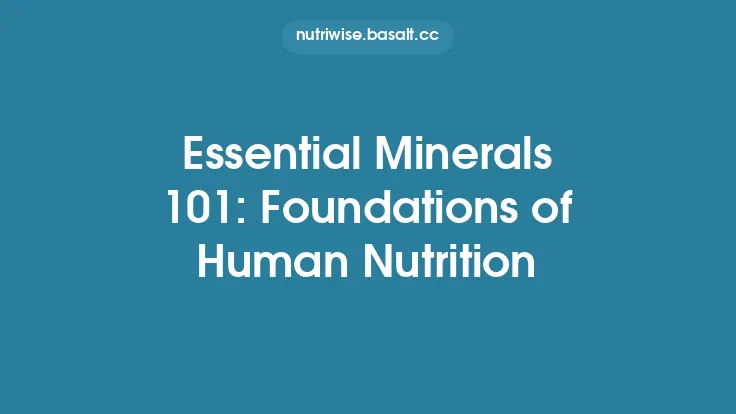Essential minerals are inorganic nutrients that the body cannot synthesize in sufficient quantities and therefore must obtain from the diet. Though they are required in relatively small amounts compared with macronutrients, their roles are indispensable for maintaining cellular homeostasis, supporting enzymatic reactions, and enabling physiological processes that keep us healthy. This article explores the most critical essential minerals beyond the well‑known calcium, iron, magnesium, and zinc, detailing their biological functions, recommended intakes, common dietary sources, and considerations for supplementation.
Potassium: The Primary Intracellular Cation
Physiological roles
- Fluid balance & osmotic regulation – Works with sodium to maintain extracellular‑intracellular fluid distribution.
- Nerve impulse transmission – Generates the repolarization phase of action potentials in neurons and muscle fibers.
- Cardiac contractility – Modulates heart rhythm; low levels can precipitate arrhythmias.
- Acid‑base buffering – Acts as a major intracellular buffer, helping to neutralize metabolic acids.
Recommended intake
- Adults: 2,600 mg (women) to 3,400 mg (men) per day (AI – Adequate Intake).
- Pregnant/lactating women: up to 2,900 mg/day.
Key food sources
- Bananas, avocados, and dried apricots (≈400 mg per serving).
- Leafy greens (spinach, Swiss chard) – 300–500 mg per cup cooked.
- Root vegetables (sweet potatoes, potatoes with skin) – 600–900 mg per medium tuber.
- Legumes (white beans, lentils) – 400–600 mg per cup cooked.
- Nuts and seeds (almonds, pumpkin seeds) – 200–300 mg per ounce.
Absorption & interaction notes
- High dietary fiber can modestly reduce potassium absorption, but the effect is clinically minor.
- Excessive sodium intake can blunt potassium’s blood‑pressure‑lowering effect; a dietary Na⁺/K⁺ ratio < 1 is often recommended for optimal cardiovascular health.
Sodium: The Principal Extracellular Cation
Physiological roles
- Volume regulation – Drives water retention in the extracellular compartment.
- Nerve conduction – Initiates the depolarization phase of action potentials.
- Nutrient transport – Co‑transports glucose and amino acids via Na⁺‑dependent transporters.
Recommended intake
- AI for adults: 1,500 mg/day (≈3.8 g of table salt).
- Upper limit (UL): 2,300 mg/day; many health agencies advise ≤ 1,500 mg for individuals with hypertension.
Key food sources
- Processed foods (cured meats, canned soups, snack foods) – major contributors.
- Naturally occurring sources: sea salt, soy sauce, olives, and certain cheeses.
- Vegetables such as celery and beetroot contain modest amounts (≈100 mg per cup).
Absorption & interaction notes
- Sodium balance is tightly regulated by the renin‑angiotensin‑aldosterone system; chronic excess can lead to hypertension and renal strain.
- Potassium‑rich diets can mitigate sodium‑induced blood‑pressure elevations.
Phosphorus: The Backbone of Energy Metabolism
Physiological roles
- Structural component – Forms hydroxyapatite crystals with calcium in bone and teeth (though calcium is covered elsewhere, phosphorus’s role is distinct).
- Energy carrier – Integral to adenosine triphosphate (ATP), nucleic acids (DNA/RNA), and phospholipids.
- pH buffering – Contributes to intracellular buffering systems.
Recommended intake
- Adults: 700 mg/day (RDA).
- Upper limit: 4,000 mg/day to avoid renal overload.
Key food sources
- High‑protein foods: poultry, fish, lean meats (≈200–250 mg per 3 oz).
- Dairy alternatives (soy milk, fortified plant milks) – 100–150 mg per cup.
- Nuts and seeds (pumpkin seeds, Brazil nuts) – 250–300 mg per ounce.
- Whole grains (brown rice, oats) – 150–200 mg per cup cooked.
Absorption & interaction notes
- Phytates (found in whole grains and legumes) can bind phosphorus, reducing its bioavailability; soaking, sprouting, or fermenting can mitigate this effect.
- Excessive phosphorus intake relative to calcium may promote secondary hyperparathyroidism, especially in individuals with chronic kidney disease.
Selenium: A Trace Element with Antioxidant Power
Physiological roles
- Component of selenoproteins – Glutathione peroxidases and thioredoxin reductases protect cells from oxidative damage.
- Thyroid hormone metabolism – Required for the conversion of thyroxine (T₄) to the active triiodothyronine (T₃).
- Immune modulation – Influences both innate and adaptive immune responses.
Recommended intake
- Adults: 55 µg/day (RDA).
- Upper limit: 400 µg/day (to avoid selenosis).
Key food sources
- Brazil nuts (≈68–91 µg per nut; 1–2 nuts meet daily requirement).
- Seafood (tuna, sardines, shrimp) – 30–50 µg per 3 oz.
- Organ meats (liver) – 30 µg per 3 oz.
- Whole grains (brown rice, whole wheat bread) – 10–15 µg per serving.
Absorption & interaction notes
- Selenium is absorbed efficiently (≈80–90%) from most foods.
- High intakes of vitamin E can synergistically enhance selenium’s antioxidant effects, but supplementation should be approached cautiously to avoid exceeding the UL.
Copper: The Redox‑Active Cofactor
Physiological roles
- Enzymatic cofactor – Supports cytochrome c oxidase (cellular respiration), superoxide dismutase (antioxidant defense), and lysyl oxidase (collagen cross‑linking).
- Iron metabolism – Facilitates iron transport by ceruloplasmin; deficiency can indirectly affect hemoglobin synthesis.
- Neurotransmitter synthesis – Involved in the formation of dopamine and norepinephrine.
Recommended intake
- Adults: 900 µg/day (RDA).
- Upper limit: 10 mg/day.
Key food sources
- Shellfish (oysters, crab) – 500–800 µg per 3 oz.
- Nuts and seeds (cashews, sunflower seeds) – 250–300 µg per ounce.
- Whole‑grain products (quinoa, barley) – 150–200 µg per cup cooked.
- Legumes (lentils, chickpeas) – 150 µg per cup cooked.
Absorption & interaction notes
- High dietary zinc can competitively inhibit copper absorption; prolonged high‑zinc supplementation may precipitate copper deficiency.
- Excessive copper intake (e.g., from contaminated water) can cause hepatic toxicity.
Manganese: The Multifunctional Enzyme Activator
Physiological roles
- Cofactor for metabolic enzymes – Involved in carbohydrate, amino‑acid, and cholesterol metabolism (e.g., pyruvate carboxylase, arginase).
- Antioxidant defense – Part of manganese superoxide dismutase (MnSOD) in mitochondria.
- Bone formation – Supports osteoblast activity (distinct from calcium‑focused bone health).
Recommended intake
- Adults: 1.8 mg/day (women) to 2.3 mg/day (men) (RDA).
- Upper limit: 11 mg/day.
Key food sources
- Whole grains (brown rice, oats) – 0.5–1 mg per cup cooked.
- Nuts (pecans, hazelnuts) – 0.5 mg per ounce.
- Leafy greens (spinach, kale) – 0.3–0.5 mg per cup cooked.
- Tea (especially black tea) – 0.2–0.4 mg per cup.
Absorption & interaction notes
- Phytates can reduce manganese absorption; however, typical dietary patterns provide sufficient bioavailable manganese.
- Excessive manganese exposure (e.g., inhalation in occupational settings) can lead to neurotoxicity, but dietary excess is rare.
Chromium: The Glucose‑Modulating Trace Element
Physiological roles
- Enhances insulin signaling – Chromium picolinate and other trivalent forms augment the action of insulin on target cells, facilitating glucose uptake.
- Lipid metabolism – May influence cholesterol synthesis pathways, though evidence is modest.
Recommended intake
- Adults: 25–35 µg/day (AI; no established RDA).
- Upper limit: 1 mg/day (based on limited data).
Key food sources
- Whole grains (whole wheat bread, barley) – 5–10 µg per serving.
- Broccoli and green beans – 5–7 µg per cup cooked.
- Meat (beef, chicken) – 2–5 µg per 3 oz.
- Brewer’s yeast – up to 30 µg per tablespoon (concentrated source).
Absorption & interaction notes
- Chromium absorption is low (≈0.5–2%) and is enhanced by vitamin C and certain amino acids.
- High-dose chromium supplementation (>200 µg/day) has not consistently demonstrated additional metabolic benefits and may cause gastrointestinal upset.
Molybdenum: The Cofactor for Detoxifying Enzymes
Physiological roles
- Component of sulfite oxidase, xanthine oxidase, and aldehyde oxidase – These enzymes are essential for the metabolism of sulfur‑containing amino acids, purines, and certain drugs.
- Detoxification – Facilitates conversion of potentially harmful sulfite to sulfate.
Recommended intake
- Adults: 45 µg/day (RDA).
- Upper limit: 2 mg/day.
Key food sources
- Legumes (beans, peas) – 30–50 µg per cup cooked.
- Whole grains (oats, barley) – 20–30 µg per cup cooked.
- Nuts (almonds, walnuts) – 10–15 µg per ounce.
- Organ meats (liver) – 30 µg per 3 oz.
Absorption & interaction notes
- Molybdenum is readily absorbed (> 80%).
- Deficiency is exceedingly rare; excess intake can interfere with copper metabolism, potentially leading to secondary copper deficiency.
Iodine: The Thyroid Hormone Builder
Physiological roles
- Synthesis of thyroid hormones (T₃ and T₄) – Critical for basal metabolic rate, neurodevelopment, and reproductive health.
- Regulation of gene expression – Thyroid hormones modulate transcription of numerous genes involved in metabolism.
Recommended intake
- Adults: 150 µg/day (RDA).
- Upper limit: 1,100 µg/day.
Key food sources
- Iodized salt – 45 µg per gram of salt.
- Seaweed (kelp, nori) – 200–2,000 µg per gram (highly variable; use with caution).
- Dairy products (milk, yogurt) – 30–50 µg per cup.
- Fish and shellfish – 50–100 µg per 3 oz.
Absorption & interaction notes
- Iodine is efficiently absorbed in the small intestine.
- Excessive iodine can precipitate thyroid dysfunction (e.g., Wolff‑Chaikoff effect).
- Selenium status influences the conversion of T₄ to T₃; adequate selenium supports optimal iodine utilization.
Fluoride: The Enamel‑Protective Anion
Physiological roles
- Dental health – Incorporates into hydroxyapatite to form fluorapatite, which is more resistant to acid demineralization.
- Bone mineralization – At appropriate levels, contributes to bone density, though excess can lead to skeletal fluorosis.
Recommended intake
- Adults: 3–4 mg/day (AI).
- Upper limit: 10 mg/day.
Key food sources
- Fluoridated drinking water – 0.7–1.2 mg/L (varies by municipal supply).
- Tea (black and green) – 0.3–0.5 mg per cup.
- Certain fish (e.g., canned sardines) – 0.2–0.4 mg per serving.
- Dental products (toothpaste, mouth rinses) – supplemental source when used as directed.
Absorption & interaction notes
- Fluoride is absorbed primarily in the stomach and small intestine; bioavailability is high (> 90%).
- Chronic ingestion of water with fluoride > 1.5 mg/L can increase risk of dental fluorosis in children.
Sulfur: The Structural Backbone of Amino Acids
Physiological roles
- Component of essential amino acids – Cysteine and methionine contain sulfur, essential for protein synthesis.
- Detoxification – Sulfation pathways in the liver rely on sulfur donors (e.g., glutathione).
- Joint health – Sulfur is a constituent of chondroitin sulfate and glucosamine, supporting cartilage integrity.
Recommended intake
- No specific RDA; adequate intake is met through consumption of protein‑rich foods providing ~10–15 g of sulfur‑containing amino acids per day.
Key food sources
- High‑protein foods: meat, poultry, fish, eggs – provide 0.5–1 g sulfur per 100 g.
- Legumes and soy products – 0.4–0.8 g per cup cooked.
- Allium vegetables (onion, garlic) – 0.1–0.2 g per serving.
- Cruciferous vegetables (broccoli, Brussels sprouts) – 0.2–0.3 g per cup cooked.
Absorption & interaction notes
- Sulfur is absorbed as part of amino acids; no separate absorption pathway.
- Excessive supplemental sulfur (e.g., high‑dose MSM) is generally well tolerated but may cause gastrointestinal upset in some individuals.
Practical Guidance for Incorporating Essential Minerals
- Prioritize Whole Foods – A varied diet rich in fruits, vegetables, legumes, nuts, seeds, whole grains, and seafood naturally supplies the spectrum of essential minerals discussed.
- Mind the Ratios – Balance sodium and potassium, and ensure adequate iodine and selenium to support thyroid health.
- Consider Bioavailability – Techniques such as soaking beans, fermenting grains, and cooking leafy greens can reduce antinutrients (phytates, oxalates) that impede mineral absorption.
- Supplement When Needed – Targeted supplementation (e.g., selenium for individuals with low soil content, iodine for those not using iodized salt) should be guided by dietary assessment or laboratory testing.
- Watch Upper Limits – While deficiencies are more common, chronic excess of certain minerals (sodium, fluoride, copper, manganese) can be harmful; adhere to established tolerable upper intake levels.
- Monitor Interactions – High-dose zinc, iron, or calcium (covered elsewhere) can interfere with copper, manganese, and magnesium absorption; even though those minerals are not the focus here, awareness of cross‑mineral interactions is essential for overall micronutrient balance.
Summary
Essential minerals—potassium, sodium, phosphorus, selenium, copper, manganese, chromium, molybdenum, iodine, fluoride, and sulfur—play distinct and non‑redundant roles in human physiology. Their functions range from maintaining electrical gradients and fluid balance to supporting antioxidant defenses, hormone synthesis, and structural integrity of tissues. By consuming a diverse array of minimally processed foods and, when appropriate, employing targeted supplementation, individuals can meet their mineral needs while avoiding both deficiency and toxicity. Understanding each mineral’s specific actions, recommended intakes, and food sources empowers consumers to make informed choices that sustain long‑term health.





